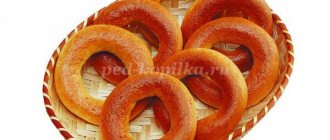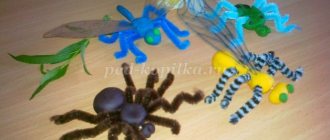MAGAZINE Preschooler.RF
Summary of educational activities on modeling on the topic “Bagels, bagels” in the 1st junior groupTeachers: Gavryushkina L.N., Buzhor I.V., Kabluchko L.B.
Educational objectives:
- consolidate the ability to divide a column (cylinder) into two parts and close them into a ring;
- develop the ability to divide plasticine into parts of different sizes and roll out columns (cylinders) of different lengths and thicknesses;
- develop the perception of shape and size, eye and fine motor skills, creative abilities.
Equipment: plasticine; planks; two ropes (red long thick and blue short thin); bagels and bagels (natural), toy “Granny” .
PROGRESS OF THE EDUCATIONAL SITUATION:
Introduction to the situation
The teacher gathers the children around him and informs them that their grandmother came to visit them, she did not come empty-handed, but brought us a treat. Guess what it is?
The ring is not simple, the ring is golden, shiny, crispy, a real treat! (bagels, bagels)
Educator: -Is there enough food for everyone? (No.)
-Why? (Only one bagel and one bagel, but there are many of us.)
-Grandma is grieving because not all the children have enough food.
-What can we do to ensure that there is enough food for everyone? (Bake a lot of bagels and bagels.)
-Do you want to help grandma bake lots and lots of bagels and bagels?
I'm sure you can do it, because it's very simple for you. If something doesn't work out, I can always help you.
Update
-What shape are the bagels and bagels? (Both bagels and round bagels.)
- That's right, they are the same - round - shape, like a ring.
-What is the difference between a bagel and a bagel? (Size: bagels are small, bagels are large.)
-What can we “bake” ? (Made from plasticine.)
We put bagels and bagels in different plates: bagels in a large blue one, and bagels in a small red one. (The teacher invites the children to start modeling. The students go to their workplaces.)
-So that we get a lot of bagels and bagels, each of you will “bake” one bagel and one bagel.
-How many items will each person bake? (Two.)
-How many parts should the plasticine be divided into to make two products? (Into two parts.) You can get to work.
(During independent activities, the teacher motivates children to successfully complete the work by pre-empting a successful result: “Having such opportunities as yours...” , “You will certainly do everything right, because you have such a sharp mind...” )
Difficulty in the situation
Most likely, most of them will divide the clay into equal parts.
-Were you able to sculpt the products so that you could find out which is which?
-Why couldn’t they? (Because we don’t know how differently a bagel and a bagel should be sculpted.)
Physical education:
Whose legs are these jumping along the path?
Whose hands are these clapping?
Our kids got up early in the morning
They dance merrily and gnaw on the steering wheel!
“Discovery” of new knowledge (mode of action)
-What should you do if you don’t know how to do it right? (Ask someone who knows).
The teacher invites the children to the demonstration table. At this time, the used plasticine is replaced with new one.
-You and I found out that a donut is larger in size than a bagel, which means that when dividing plasticine, the parts should be the same or different in size? (Different: for a bagel - a smaller part, and for a bagel - a larger one.)
-Look, we break the column not in the middle, but a little closer to one edge, we get different parts - large and small. (The teacher shows how to divide the column into two different parts.)
-What will we do with each part? (Roll out the column and connect the ends to make a ring.)
-Right. From the large part we roll out a long and thick column, from the small part - a short and thin one. (The teacher performs the appropriate actions and comments on them.)
(Showing two columns, the teacher offers to compare them in size and guess which bagel will be made from, and which bagel will be made from. He closes the columns into rings. Places them on plates (bagels on blue, bagels on red).
Inclusion of new knowledge (method of action) into the child’s system of knowledge and skills
(The teacher, together with the children, pronounces the algorithm for completing the task.)
-What do we do first? (We divide the plasticine into two different parts: large and small.)
-What do we do with the big piece?
(Roll out a large piece into a long, thick column and connect the ends to make a ring.)
-What do we do with a small piece? (Roll out a small piece into a short and thin column, connect the ends to make a ring.)
(Children independently divide the material into parts, roll out the columns into long thick ones and short thin ones. The teacher checks whether they managed to prepare shapes that are contrasting in size.
During this stage of work, hidden help is provided through a hint, an instruction, a wish: “It’s better to start with...” , “Pay attention...” .
Children close the columns into rings and place them in plates of the given color and size.
For pupils who have experienced difficulties, the teacher uses the technique of “personal exclusivity” - indicates the importance of the efforts of this particular child in a given activity ( “Only you could...” , “Only you I can trust...” ).
Comprehension
(The teacher gathers the children around him.)
-Who did we help today? (Listens to all the children’s answers.)
-You were able to help your grandmother because you know how to divide plasticine into different parts and sculpt bagels and bagels from sticks.
-That's how many delicious bagels and bagels we got. Well done everyone! Thank you.
(At the last stage, the results of the children’s work are assessed individually).
We played well, we showed our prowess. Now let’s drink some tea and talk about this and that.
| Next > |
Modeling lesson in the second junior group “Baranki for guests”
Ekaterina Valentinovna.
Modeling lesson in the junior group “Barankas for guests”
Purpose:
Teach children to roll out sausages and make bagels.
Tasks:
Educational
– promote the formation of the ability to roll a sausage from plasticine between the palms in a circular motion; the ability to convey the form of an object, to contribute to the enrichment of vocabulary.
Developmental
– promote the development of fine motor skills and attention.
Educational
– contribute to the development of a caring attitude towards others.
Material:
Plasticine, boards, napkins, a picture of bagels,
Toys:
Teddy bear, squirrel, bunny, hedgehog. Tray, plates for bagels.
Preliminary work:
accumulation of vocabulary (words “Hello”, “Please”, “Thank you” and other polite words); modeling of different sausages (large and small, organization of the role-playing game “Guests”.
Educational area:
Artistic and aesthetic development.
Progress of the lesson
1. Organizational point:
Educator:
Guys, come in, look, we have guests today, let's say hello to our guests.
Children:
Hello.
Educator:
Oh guys, we have another guest today: and to get to know him, I’ll read you a nursery rhyme:
Through rubble and ravines
Teddy Bear walks with a clubfoot
He loves bees' honey
Yes, he picks raspberries from the branches.
Educator:
Guys, who is this nursery rhyme about?
Children:
About the bear.
Educator:
And here is our Teddy Bear (Shows the Teddy Bear toy).
Bear:
Hello guys, today is my birthday, and to me
guests arrived.
Educator:
And what kind of guests came to Mishka? We will find out now. (the screen opens).
Educator:
Guys, tell me who came to Mishka’s birthday?
Children:
Squirrel, bunny, hedgehog.
Educator:
Oh bear, the teapot is standing, the guests have gathered, and where is the treat for the guests?
Bear:
Guys, I don’t know what I can treat my guests to.
Educator:
Bear, don’t be upset, we will help you. Guys, please tell me what I can treat my guests to.
Children:
They offer their options.
Educator:
Guys, I suggest you help Mishka prepare delicious bagels for his guests. Tell me, what shape are the bagels?
Children:
children's answers.
Educator:
Right.
2. Main part
Educator:
Before preparing the bagels, let's stretch our fingers.
Finger gymnastics:
We asked our stove
What should we bake (children straighten their arms forward, palms up)
We asked the stove to knead the dough (Clench and unclench fingers)
Roll out the dough with a rolling pin
Rolled out without getting tired (Move your hands back and forth with your palms down)
We are for Mishka on his birthday
Let's prepare some treats (Bake pies).
Educator:
Well done. Our fingers have warmed up, now come in and take your seats at the tables. Bear, sit with us. Look, I have a steering wheel. What shape is my steering wheel?










